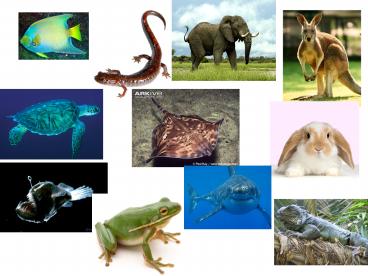Five Kingdom Classification System - PowerPoint PPT Presentation
Title:
Five Kingdom Classification System
Description:
Five Kingdom Classification System – PowerPoint PPT presentation
Number of Views:7176
Avg rating:3.0/5.0
Title: Five Kingdom Classification System
1
(No Transcript)
2
Classification System of Organisms
- Once upon a time, all living things were lumped
together into two kingdoms, namely plants and
animals
3
Plant and Animal
4
- Animals included every living thing that moved,
ate, and grew to a certain size and stopped
growing. - Plants included every living thing that did not
move or eat and that continued to grow throughout
life.
5
Five Kingdom Classification System
6
- It became very difficult to group some living
things into one or the other, so early in the
past century the two kingdoms were expanded into
five kingdoms - Protista (the single-celled eukaryotes)
- Fungi (fungus and related organisms)
- Plantae (the plants)
- Animalia (the animals)
- Monera (the prokaryotes).
7
- Kingdoms are divided into categories called
phyla, each phylum is divided into classes, each
class into orders, each order into families, each
family into genera, and each genus into species.
8
KINGDOM MONERA (monerans) -
- Single cell
- No true nucleus - prokaryote (genetic material
scattered and not enclosed by a membrane) - Some move (flagellum) others don't
- Some make their own food (autotrophic) others
can't make their own food (heterotrophic) - Examples - bacteria
- cyanobacteria
9
KINGDOM PROTISTA (protists)
- Single cell
- Have a true nucleus eukaryote
- Some move (cilia, flagella, pseudopodia) others
don't - Some are autotrophic others are heterotrophic
- Examples - amoeba, diatom, euglena, paramecium,
some algae (unicellular), etc
10
KINGDOM FUNGI
- Multi cellular
- Have nuclei
- Mainly do not move from place to
placeHeterotrophic (food is digested outside of
fungus) - Examples - mushroom, mold, puffball,
shelf/bracket fungus, yeast, etc
11
KINGDOM PLANTAE (plants)
- MulticellularHave nucleiDo not move
Autotrophic - Examples - multicellular algae, mosses, ferns,
flowering plants (dandelions, roses, etc.),
trees, etc
12
KINGDOM ANIMALIA (animals )
- Multicellular
- Have nuclei
- Do move
- Heterotrophic
- Examples - sponge, jellyfish, insect, fish, frog,
bird, man
13
- Kingdom
- Phylum
- Class
- Order
- Family
- Genus
- Species
14
Phylum in Animalia
- Porifera (sponges)
- Cnidaria (jellyfish, hydras, sea anemones,
Portuguese man-of-wars, and corals) - Platyhelminthes (flatworms, including planaria,
flukes, and tapeworms) - Nematoda (roundworms, including rotifers and
nematodes) - Mollusca (mollusks, including bivalves, snails
and slugs, and octopuses and squids) - Annelida (segmented worms, including earthworms,
leeches, and marine worms) - Echinodermata (including sea stars, sea
cucumbers, sand dollars, and sea urchins) - Arthropods (including arachnids, crustaceans,
millipedes, centipedes, and insects) - Chordata (animals with nerve chords - this group
includes the vertebrates)
15
Classes in Cordata
16
Homework make a family tree
17
Homework
- List of organisms
- Worm, turtle, mouse, centipede, kangaroo,
jellyfish, spider, horse, frog, snake, bird, cow,
whale, shark, gold fish, coral, Squirrel,
dolphin, beetle, snail, starfish and sponge.
18
Class assignment
- Write all the animals under kingdom.
- Place Chordata in the 4th block under Phylum.
- Write the Classes of Cordata under Class.
- Koala bear and what mammal are related? Place
all the other related mammals in groups of two or
Orders.
19
(No Transcript)
20
Orders1 2 3 4































